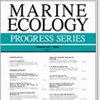Evaluating the time to detect biological effects of ocean acidification and warming: an example using simulations of purple sea urchin settlement
IF 2.2
3区 环境科学与生态学
Q2 ECOLOGY
引用次数: 0
Abstract
ABSTRACT: Ocean acidification (OA) and ocean warming driven by climate change are important stressors for marine species and systems, but documenting and detecting their long-term impacts on biological responses outside of laboratory settings are challenging due to natural variability caused by complex processes and interactions. We used settlement of purple sea urchins Strongylocentrotus purpuratus in the Southern California Bight (USA) over 6 yr as an example data set to parameterize a simulation model for exploring the time needed to detect environmental effects on a biological response. A generalized linear model was used to describe an index of urchin settlement as functions of pH, sea surface temperature (SST), sea surface salinity (SSS), and spatio-temporal factors, demonstrating that settlement was negatively associated with pH (i.e. lower settlement at higher pH) and positively associated with SST and SSS. Monte Carlo simulations were developed from this base model under a variety of alternative scenarios to estimate the time to detect: (1) annual trends in pH and SST time series, (2) pH and SST effects on urchin settlement, and (3) annual trends in urchin settlement. Time to detect pH and SST effects was predominantly influenced by the underlying strength of the relationships and the model uncertainty. Time to detect annual trends in settlement was more sensitive to the severity of long-term OA and warming trends, which had cumulative (at times opposing) effects. This study highlights the variable time scales (2-60+ yr) that may be necessary to detect biological responses to OA and ocean warming and the sensitivity to different assumptions of the study system.评估发现海洋酸化和变暖对生物影响的时间:以模拟紫色海胆沉降为例
摘要:气候变化导致的海洋酸化(OA)和海洋变暖是海洋物种和系统的重要压力源,但由于复杂过程和相互作用导致的自然变异,在实验室环境之外记录和检测它们对生物反应的长期影响具有挑战性。我们以南加州湾(美国)紫海胆 Strongylocentrotus purpuratus 6 年的沉降为例,建立了一个模拟模型的参数,用于探索检测环境对生物反应的影响所需的时间。利用广义线性模型描述了海胆沉降指数与 pH 值、海面温度(SST)、海面盐度(SSS)和时空因素的函数关系,结果表明沉降与 pH 值呈负相关(即 pH 值越高沉降越低),与 SST 和 SSS 呈正相关。根据这一基础模型,在多种备选方案下进行了蒙特卡罗模拟,以估算发现以下问题的时间:(1) pH 和 SST 时间序列的年度趋势;(2) pH 和 SST 对海胆沉降的影响;(3) 海胆沉降的年度趋势。检测 pH 和 SST 效应的时间主要受相关关系的基本强度和模型不确定性的影响。发现海胆沉降年度趋势的时间对长期 OA 和变暖趋势的严重程度更为敏感,因为它们具有累积效应(有时是对立的)。这项研究强调了检测生物对 OA 和海洋变暖的反应可能需要的不同时间尺度(2-60 多年),以及对研究系统不同假设的敏感性。
本文章由计算机程序翻译,如有差异,请以英文原文为准。
求助全文
约1分钟内获得全文
求助全文
来源期刊

Marine Ecology Progress Series
环境科学-海洋学
CiteScore
5.30
自引率
8.00%
发文量
238
审稿时长
3 months
期刊介绍:
The leading journal in its field, MEPS covers all aspects of marine ecology, fundamental and applied. Topics covered include microbiology, botany, zoology, ecosystem research, biological oceanography, ecological aspects of fisheries and aquaculture, pollution, environmental protection, conservation, and resource management.
 求助内容:
求助内容: 应助结果提醒方式:
应助结果提醒方式:


